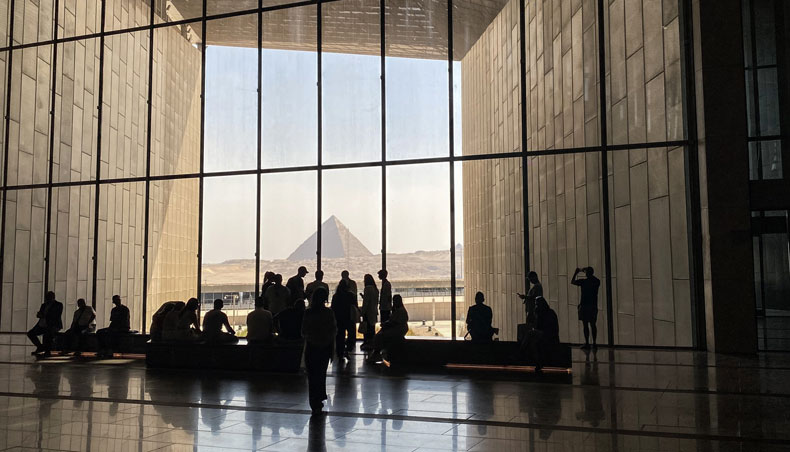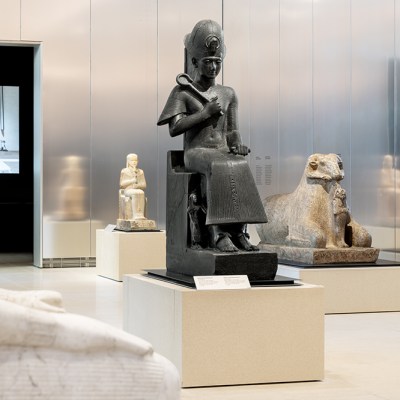From the July/August 2025 issue of Apollo. Preview and subscribe here.
Whizzing along the motorway through Giza in late May, I gazed out of the taxi window at friends sharing two-wheeled rides, families piled into cars, and a sprawl of beige and orange buildings incised with balconies and draped in drying clothes. Before long, my attention would be pulled from these everyday details of modern Egyptian life and towards a bygone era as placid, pointed structures rose up from the desert horizon, appearing and disappearing behind apartment blocks. Beige, on beige, on beige against a startling expanse of blue. I couldn’t hope to emulate the locals’ easy indifference when faced with man-made constructions dating back 4,500 years.
My destination, however, was another, far more recent feat of engineering on the Giza Plateau. The Grand Egyptian Museum (GEM) – currently scheduled to open fully in late 2025 – is the centrepiece of an ongoing redevelopment of the archaeological site. The museum was first conceived in 1992, but the search for a design was launched only in 2002 and construction didn’t begin until 2012. More than a decade and $1 billion later, the GEM is the largest museum in the world dedicated to a single civilisation and sits within a larger complex of manicured gardens that covers 500,000 square metres. Some 100,000 exhibits have been retrieved from storage and small, regional museums. Since late last year, public access to the GEM has been granted in phases.
On my visit, almost everything was in place, except for one final flourish: the transfer of King Tut’s golden treasures from the old Egyptian Museum in Cairo. There, famous pieces such as the funerary mask and an ornately bedazzled throne easily astonish, despite being spread over a series of poky, dim and overcrowded galleries. No doubt their display at the GEM, with 5,000 more of the boy king’s possessions, will be more spectacular. The Cairo building, a charmingly fusty pink palace that was Africa’s largest museum when it was built in 1901, will remain open to house artefacts that may have less blockbuster appeal but are still well worth a visit: the antiquities from the royal tombs of Tanis, for instance, are easily as dazzling as those found in Tutankhamun’s tomb.
Sliding from the car into the 35-degree heat, I approached the GEM’s sleek, wedge-like structure, clad in limestone and covered in an interlocking pattern of pyramidal forms. Beneath palm trees, peppy museum staff in tennis-club-style uniforms looked more than happy to help, and some ferried visitors around on golf carts. I wondered how this visit would compare to my recent experiences, in Luxor, of being dwarfed by 20-metre columns in a temple ruin or crawling into decorated, subterranean chambers. Freshly immersed in the context from which these museum objects were necessarily divorced, I prepared myself to encounter them in glass cases.
A view of the pyramids on the Giza Plateau from inside the museum. Photo: Mohamed Eishahed/Anadolu via Getty Images

The building’s relatively modest, low-lying exterior, not unlike that of an airport or shopping centre, belies the sheer expanse of its insides. If anything, the main atrium risks swallowing up its 3,200-year-old centrepiece, an 11 metre-high, 83-tonne statue of Ramesses II that was discovered in pieces near ancient Memphis in 1820. That this is even possible exposes one dilemma of building a contemporary temple to ancient monuments. These objects were designed to dominate their surroundings – and they did, for centuries. It’s not an effect that should be diluted. Thankfully, the museum’s grand staircase strikes the right balance. Its mammoth yet minimalist and cascading form is an accentuating stage for the various statues, sarcophagi and stelae that you’ll pass on your way up. It is a melding of the old and new that feels somehow as natural as the Giza skyline. At the apex, a viewing platform looks out on to the great pyramids.
I had been prepared to encounter such flashy attractions at the GEM, which has been successfully designed to impress through the blunt deployment of scale. The galleries, however, had remained an afterthought in my mind. Happily, they comprise a suite of open-plan spaces through which sightlines are hardly interrupted. With this area arranged over the same slope as the staircase, visitors work their way downhill on a roughly chronological journey from prehistoric times to the Greco-Roman period, by way of the Middle Kingdom and New Kingdom. Each of the four eras is split across three vertical thematic strands – Society, Kingship, and Beliefs – to create a total of 12 galleries.
It is easy to feel overwhelmed by Egypt’s abundance of vessels, coffins, figurines and artefacts covered in hieroglyphics, but the exhibits are enlivened by their organisation into curated clusters that are eye-catching, if a bit too symmetrical. The large, transparent display cases have the effect of layering neighbouring objects. One highlight is a set of 40 miniature wooden soldiers that was found in the tomb of Mesehti, a local governor during the end of the First Intermediate Period. Objects like these, intended to offer protection in the afterlife, provide rare insight into members of society who were not otherwise well-documented. The soldiers have tidy bobbed haircuts, carry lances and shields and wear short skirts for ease of movement. They make a particularly elegant contrast with a stately black sarcophagus.
There is no set path to navigate the galleries, which feels refreshingly undidactic. The wall texts are probably too brief but, where possible, they introduce a humanising context for the material. The thoughtful pairing of one scuffed-up, unfinished statue next to a cracked wooden mallet invites us to imagine how these tools were once held and used by real artisans. Fragments of papyri are usually indecipherable but, at the GEM, they are displayed alongside a scribe’s palette for grinding and storing ink and the burnishers that helped seal pigment into the sheet after writing.
Last year, more than 15 million tourists visited Egypt. The country is hoping to welcome 30 million annual visitors by 2030 and the GEM is central to this mission. To the extent that it is possible to package up ancient Egypt into a four-hour experience that could be slotted in before a week at the beach, it does so. But it is not a soulless exercise. This epic undertaking is clearly born of a desire to do justice to a civilisation that has handed down untold riches with a unique power to delight audiences the world over. The GEM is a fitting tribute.
From the July/August 2025 issue of Apollo. Preview and subscribe here.


